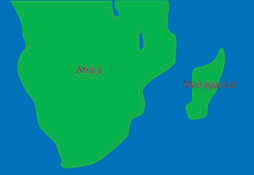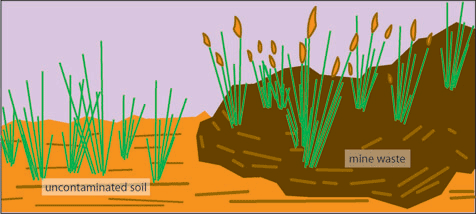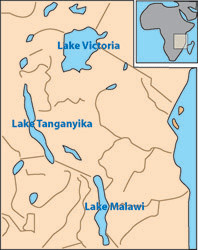 username@email.com
username@email.com
Natural selection is an element of microevolution. Microevolutionary change happens at the tiniest level—the allele that carries the details of a trait. Located at a specific position on a chromosome, an allele contains one form of a gene—the unit of heredity that determines a particular characteristic. Genes are passed from one generation to the next.
Alleles are responsible for inherited traits, including characteristics such as hair color, eye color, and blood type. An allele can be either dominant or recessive. Genotypes are the symbolic expression of the allele pairs that are not observable by the naked eye. Phenotypes are the expressed traits that are observable, such as hair and eye color.
From one generation to the next, sexual reproduction produces allele diversity, shifts and changes. A large, viable population of a species is able to adapt to changing conditions through genetic variability. The more alleles present, the greater the potential for a species to survive the ebb and flow of environmental change.
The Punnett Square is the graphical expression of genotypes and can be used to graphically predict the possible genotypes of offspring in breeding pairs. Genotypes can be either homozygous (TT or tt) or heterozygous (Tt). For example, a male and female breed and both have the heterozygous gene (Tt), therefore the cross is expressed (Tt X Tt). T represents the dominant allele for brown hair and t represents blonde hair. The offspring of this breeding pair would display genotypes (TT), (Tt) and (tt), as shown in the Punnett Square below.
The genotypes reflect the possible combinations of alleles as a 1:2:1 ratio based on the parental traits. Regarding phenotypes, the ratio is 3:1—meaning 3 offspring have brown hair and 1 offspring has blonde hair.
In a normal breeding population one might expect to see this distribution of genotypes in the 1:2:1 genotypic ratio. While individual breeding pairs might not produce all of the genotypes, a large population size would compensate for missing allele distributions.
What is the phenotypic ratio for the offspring of a homozygous individual (AA) and a heterozygous individual (Aa)?

The correct choice is C. All individuals will express the dominant A trait phenotypically. Choice A is the genotypic ratio for a heterozygous cross. Choice B is the genotypic ratio for the cross. Choice D is the phenotypic ratio for a heterozygous cross.
Genetic drift occurs in small populations and is the change in allele frequency in that population. In small populations, the frequency of an allele can be drastically changed by a catastrophic event such as a disease. Similarly, founder effect is the establishment of a new population by a small number of individuals from an existing larger population. As a result the new population may be dissimilar in the frequency of both genotype and phenotype from the original population.
Under heterozygous breeding conditions, a very small population of adults could have significantly different results from the larger parent population. If there were no offspring born with the homozygous recessive (tt) genotype, the genetic information would be lost. Without a large population size to compensate for individual reproductive differences, the small population could lose the (tt) genotype within a single generation.
CASE IN STUDY: Founded in the late 1700s the Amish communities of North America are facing challenges of genetic drift. From microcephaly to dwarfism to other inherited disorders, Amish families have very little genetic variation from the individuals who were their founders several generations ago. Amish are an example of both genetic drift and the founder effect. A small number of individuals migrated to North America to initiate the Amish community. The migrants were representatives of a much larger population in Europe. However, they became geographically isolated. They isolated themselves further by being a closed breeding group. New genetic information has not been added. Although members of a larger population, their limited numbers in North America determined the genetic information passed to later generations. Over time, inbreeding has led to the loss of genetic variation within the community. When compared to blood groups of North Americans in general, the Amish display distinctly limited allele frequencies. Inbreeding is resulting in not only genetic limitations but also a rise in inherited disease.
What is an example of genetic drift?
If you chose B, you are correct! Other examples of genetic drift include selective pressures and changes in migration. Directional selection refers to a trait being selected against or in favor of another. Polymorphic population is the effect of disruptive selection. Habitat loss is a cause of genetic drift, not an example.
What important outcome do genetic drift and founder effect have in common?
The correct answer is A. Choice B is a component of both, but not an outcome. Choice C deals with sexual selection. Choice D refers to disruptive selection.
What do the elephant seal and the cheetah have in common? These animals have survived the bottleneck effect, a unique type of founder effect. Caught in a genetic bottleneck by hunting, habitat loss, illness, natural selection, disasters such as floods, fires or earthquakes, or separation through migration, a species may be reduced to a very small population size. The northern elephant seal and cheetah are both bottleneck effect survivors.


Wild cheetah populations currently exist in southern and eastern Africa. Research indicates that cheetahs display characteristics of inbreeding. At one time, the cheetah population must have been reduced to very low numbers. In order for the species to survive, individuals bred with other closely related individuals. As animals inbred they passed along the limits of their individual genetic information. Today the worldwide population of cheetahs is nearly identical in genetic makeup. The total cheetah population may be sizeable but it is vulnerable. Disease, increasing genetic defects, and sudden environmental changes could be devastating to the wild cheetah population.
The northern elephant seal suffers from a similar fate. These animals were hunted to the brink of extinction because of their enormous reserves of body blubber. Hunted until they were no longer an economically viable product, the population was reduced to less than 100. These few individuals became the source of genetic information for the entire future of the northern elephant seal. Slowly the animals began to recover. The implementation of the Marine Mammal Protection Act of 1972 enhanced the species’ recovery potential. Today the population size may be as large as 150,000 individuals. Despite their limited genetic variation, the species is recovering; however, like the cheetah, a sudden change in their environment or the impact of a disease could destroy the whole population.
As scientists observe other species that have survived the bottleneck effect they have begun to gather data about its overall impact. While species may survive and return to significantly large populations, the genetic variation is significantly reduced. This decline in variation leads to a decline in overall measures of fitness. Species that once survived shifts in environmental conditions because of a wide range of genetic resources and adaptive potential have dwindled in their overall capability to change with the times. Species such as the black-footed ferret, northern elephant seal, cheetah, songbirds, whooping cranes and many others continue to recover in numbers while remaining at genetic risk for survival.
The Mexican gray wolf was hunted to near-extinction before the last half dozen individuals were put into a captive-breeding program. This is an example of
The correct answer is C. With only a few founding members of the endangered Mexican wolf, genetic diversity of the subspecies today (300 individuals) is significantly less diverse than the original population. Genetic drift and founder effect deal with a small population moving to an isolated geographic area and multiplying rapidly. That was not the case for the Mexican wolf. Disruptive selection acts in the middle of a trait’s distribution, which is unknown in regards to the Mexican wolf.
Macroevolution describes the large-scale changes to an entire species. Occurring at the pace of geologic time, macroevolutionary change may go unobserved in a human lifetime. Macroevolution describes the loss or gain of species.
The loss, or extinction, of entire species has occurred throughout the course of Earth’s history. Extinction is considered a natural part of the ebb and flow of life. From fossil records scientists have determined that many species have lived, thrived, and ultimately become extinct. Species extinctions generally occur through a process of slow change.
Fossil records also indicate that there have been at least five periods of mass extinction. These extinctions involved the catastrophic loss of species. For example, at the end of the Cretaceous period, 85% of Earth’s species disappeared. Adaptive radiation is the process of new species development following a mass extinction. Conditions created by the global change that led to the mass extinction, open the way for new ecological opportunities and creative bursts of species development.
Following a mass extinction, what is the term for the process of new species development?
The correct choice is D. Microevolution occurs at the tiniest level (the allele) and includes natural selection, genetic drift, founder effect, and bottleneck effect. Macroevolution describes the major loss or gain of species, usually unobserved during a human’s lifetime.
Many factors influence the general extinction process. Natural disasters such as volcanic eruptions, earthquakes, and hurricanes can wipe out entire species in a location. Climate change, habitat destruction, and competition between species contribute to extinction pressure. Changes in predators, parasites, and disease may also affect an entire species.
Extinction can be brought about by biological characteristics of species themselves. Species that are highly specialized, such as the koala, rely on a very specific food supply. The loss of certain eucalyptus species to deforestation has adversely affected koala populations. By comparison, coral reef species rely on precise habitat conditions. Commercial development of coastal areas has put environmental pressures on certain coral species. The corals themselves are unable to migrate or relocate to better habitat conditions. Additional risk factors include low species population numbers and slow reproductive growth capacities.
Finally, human population growth has put a significant strain on species survival. Increases in human populations have created competitive conditions for space. Construction destroys habitat needed by endangered species. At the same time, it divides the space already used by some species; isolating animals and plants into small pockets making access to mates difficult. These conditions create isolation that leads to genetic drift, bottlenecks, and extinction. Humans have also begun introducing non-native species into areas where they do not naturally occur. In many cases these introduced species out-compete existing native plants and animals. Introduced species cause devastating effects on local wildlife populations. Human impact on species may be increasing extinction rates throughout the world.
While extinction continues, new species are also evolving. Speciation is the evolutionary formation of new species. Like extinction, speciation is an ongoing evolutionary process. New species develop out of changes or splits in pre-existing populations. As organisms assume best-suited adaptations for their environment, they also become unable to interbreed. New species are formed in the process.

Eastern coast of Africa and Madagascar
Lemurs are a unique group of primates found only on the island of Madagascar. When this island separated from mainland Africa, the lemurs became isolated from the process of primate evolution. The Madagascar lemurs now represent their own group of primates. They are also an example of allopatric speciation. Allopatric speciation occurs when individuals become geographically isolated. Over time, the lemurs of Madagascar have developed adaptations making them distinctly different from the primates of Africa. The lemurs have adaptations specific to the diverse habitats of the island itself.
By contrast, parapatric speciation occurs without geographic barriers for reproduction. Populations of species may share bordering territory without sharing genetic information. An example of this is the grass species Anathoxan odoratum, which has been observed in an area where soil has become contaminated by heavy metals. Some of the grass has adapted tolerance to the soil toxicity, while other grass is intolerant and only grows successfully in the neighboring uncontaminated soil. Growing in close range they could fertilize one another. Through evolution, however, one has developed an earlier flowering time than the other. Gene flow is beginning to cease between the tolerant and intolerant grass neighbors. This could be the start of parapatric speciation.

When does parapatric speciation occur?
The correct choice is C. Choice A refers to allopatric speciation. Choice B refers to microevolution, such as natural selection, genetic drift, founder effect, and bottleneck effect. Choice D refers to macroevolution.
Evolutionary changes to a single species leading to the formation of two or more new species are called sympatric speciation. Sympatric speciation is a relatively speedy evolutionary process in which new species develop within overlapping ranges. The East African Great Lakes have provided opportunities for researching sympatric speciation.

A map of Lake Victoria, Tanganyika, and Malawi
The small, deep crater lakes have uniform shorelines and significantly diverse populations of cichlid fish. DNA analyses of the cichlid species found them to be genetically similar within their individual lakes. Because the lakes are isolated from other water supplies by the natural crater rims, it is thought that cichlid species’ diversity developed from within. Founder individuals served as the basis for current, widely diverse populations. The cichlids move throughout the entire lake encountering the diversity of all lake occupants. They do demonstrate some ecological isolation in feeding styles ranging from open water to bottom feeders. These ecological differences may have provided the beginning of selective mating and speciation. All of the cichlids continue to use the lake bottom as primary breeding territory further supporting the potential of sympatric speciation.
Sympatric speciation is more prevalent in plant species. Yellow bananas, cultivated wheat, intermediate rhododendron and Appalachian spleenwort ferns are examples of new plant species as a result of sympatric speciation. The acquisition of extra sets of chromosomes is the process supporting plant sympatric speciation. Sympatric speciation generally occurs in the range of the parent species and as mention with cichlids, is a speedy evolutionary change. A parent species will acquire extra chromosomes or hybridize to form new species. Either strategy reproductively isolates the new species.